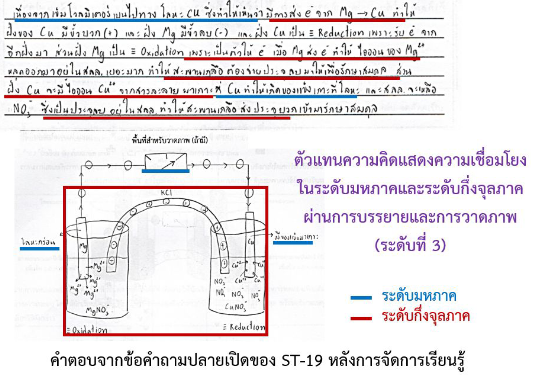การพัฒนาการด้านสมรรถนะในการนำเสนอตัวแทนความคิดของนักเรียนระดับชั้นมัธยมศึกษาปีที่ 6 ในหัวข้อ เซลล์เคมีไฟฟ้า ผ่านการจัดการเรียนรู้โดยใช้แบบจำลองเป็นฐาน
Main Article Content
บทคัดย่อ
สมรรถนะในการนำเสนอตัวแทนความคิดจัดเป็นหนึ่งสมรรถนะสำคัญที่มุ่งเน้นให้นักเรียนเป็นผู้สร้าง เลือกใช้ตัวแทนความคิดที่หลากหลายในการวิเคราะห์ ตีความ รวมถึงสะท้อน และวิพากษ์ตัวแทนความคิดที่นำเสนอ งานวิจัยนี้เป็นงานวิจัยเชิงคุณภาพมีวัตถุประสงค์เพื่อศึกษาการพัฒนาการด้านสมรรถนะในการนำเสนอตัวแทนความคิดของนักเรียนเมื่อเรียนรู้ผ่านการจัดการเรียนรู้โดยใช้แบบจำลองเป็นฐานในหัวข้อเซลล์เคมีไฟฟ้า โดยกลุ่มที่ศึกษาในงานวิจัยนี้คือ นักเรียนระดับชั้นมัธยมศึกษาปีที่ 6 จำนวน 23 คน เก็บรวบรวมข้อมูลก่อนและหลังการจัดการเรียนรู้โดยใช้แบบจำลองเป็นฐานจากแบบวัดสมรรถนะการนำเสนอตัวแทนความคิดในหัวข้อเซลล์เคมีไฟฟ้า ทำวิเคราะห์ข้อมูลเชิงคุณภาพโดยใช้การวิเคราะห์เชิงเนื้อหาและการวิเคราะห์เชิงอุปนัยเพื่อจัดระดับของสมรรถนะของการนำเสนอตัวแทนความคิด ผลการวิจัยพบว่า 1) หลังการจัดการจัดการเรียนรู้นักเรียนมีพัฒนาการด้านสมรรถนะในการนำเสนอตัวแทนความคิดโดยสามารถอธิบายปรากฏการณ์ที่เกิดขึ้นในจุลภาค (ระดับที่ 2) รวมถึงเชื่อมโยงปรากฏการณ์ในระดับมหภาค และจุลภาค (ระดับที่ 3) แต่อย่างไรก็ตามนักเรียนยังไม่สามารถสะท้อน และวิพากษ์คุณสมบัติของตัวแทนความคิดที่นำเสนอได้ นอกจากนี้งานวิจัยพบว่านักเรียนบางคนก่อนและหลังการจัดการเรียนรู้โดยใช้แบบจำลองเป็นฐานไม่เกิดการเปลี่ยนแปลงของสมรรถนะในการนำเสนอตัวแทนความคิด 2) หลังการจัดการเรียนรู้นักเรียนสามารถเลือกใช้รูปแบบในการนำเสนอตัวแทนความคิดภายนอกที่มีความหลากหลายที่ความสอดคล้องกับความเป็นนามธรรมต่อแนวคิดทางเคมีมากขึ้น 3) ตัวแทนความคิดที่นักเรียนนำเสนอมีความสัมพันธ์กับมโนทัศน์ในหัวข้อเซลล์เคมีไฟฟ้า
Article Details
เอกสารอ้างอิง
ชาตรี ฝ่ายคำตา. (2563). กลยุทธ์การจัดการเรียนรู้เคมี. กรุงเทพฯ: จุฬาลงกรณ์มหาวิทยาลัย.
พนิดา กระทุ่มนอก และร่มเกล้า จันทราษี. (2562). ความสามารถในการสร้างตัวแทนความคิด เรื่อง เซลล์กัลวานิก ของนักเรียนชั้นมัธยมศึกษาปีที่ 5 ที่เรียนรู้ด้วยการสร้างแบบจำลอง. วารสารวิจัยมหาวิทยาลัยขอนแก่น (ฉบับบัณฑิตศึกษา) สาขามนุษยศาสตร์และสังคมศาสตร์. 7(2), 36-47.
อภิวัฒน์ ศรีกันหา และปัฐมาภรณ์ พิมพ์ทอง. (2558). การศึกษามโนมติและตัวแทนความคิด เรื่อง การเกิดพันธะไอออนิก ของนักเรียนระดับชั้นมัธยมศึกษาปีที่ 4 โดยการสอนเพื่อเปลี่ยนแปลงมโนมติ. วารสารศึกษาศาสตร์ ฉบับวิจัยบัณฑิตศึกษา มหาวิทยาลัยขอนแก่น, 9(3), 213-221.
Aubusson, P. J., Harrison, A. G., & Ritchie, S. M. (2006). Metaphor and Analogy. In Metaphor and Analogy in Science Education (pp. 1-9). Springer, Dordrecht.
Briggs, M., & Bodner, G. (2005). A Model of Molecular Visualization. In Visualization in Science Education (pp. 61-72). Springer, Dordrecht.
Dolphin, G., & Benoit, W. (2016). Students’ Mental Model Development During Historically Contextualized Inquiry: How the ‘Tectonic Plate’Metaphor Impeded the Process. International Journal of Science Education, 38(2), 276-297.
Gkitzia, V., Salta, K., & Tzougraki, C. (2020). Students’ Competence in Translating Between Different Types of Chemical Representations. Chemistry Education Research and Practice, 21(1), 307-330.
Gilbert, J. K. (2005). Visualization: A Metacognitive Skill in Science and Science Education. In Visualization in Science Education (pp. 9-27). Springer, Dordrecht.
Gilbert, J. K., & Justi, R. (2016). Learning Scientific Concepts From Modelling-Based Teaching. In Modelling-Based Teaching in Science Education (pp. 81-95). Springer, Cham.
Gilbert, J. K., & Treagust, D. F. (2009). Introduction: Macro, Submicro and Symbolic Representations and the Relationship Between Them: Key Models in Chemical Education. In Multiple Representations in Chemical Education (pp. 1-8). Springer, Dordrecht.
Hand, B., Gunel, M., & Ulu, C. (2009). Sequencing Embedded Multimodal Representations in a Writing to Learn Approach to the Teaching of Electricity. Journal of Research in Science Teaching: The Official Journal of the National Association for Research in Science Teaching, 46(3), 225-247
Hilton, A., & Nichols, K. (2011). Representational Classroom Practices That Contribute to Students’ Conceptual and Representational Understanding of Chemical Bonding. International Journal of Science Education, 33(16), 2215-2246.
Ibrahim, B., & Rebello, N. S. (2013). Role of Mental Representations in Problem Solving: Students’ Approaches to Nondirected Tasks, Physical Review Special Topics - Physics Education Research, 9(2), 1–16.
Johnstone, A. H. (2006). Chemical Education Research in Glasgow in Perspective. Chemistry Education Research and Practice, 7(2), 49-63.
Kemmis, S., & McTaggart, R. (2005). Participatory Action Research: Communicative Action and the Public Sphere. In N. K. Denzin & Y. S. Lincoln (Eds.), The Sage Handbook of Qualitative Research (pp. 559- 604). Thousand Oaks: SAGE Publications Ltd.
Kozma, R. (2003). The Material Features of Multiple Representations and Their Cognitive and Social Affordances for Science Understanding. Learning and Instruction, 13(2), 205-226.
Kozma, R., & Russell, J. (2005). Students Becoming Chemists: Developing Representational Competence. In Visualization in Science Education (pp. 121-145). Springer, Dordrecht.
Krell, M., Walzer, C., Hergert, S., & Kr€uger, D. (2017). Development and Application of a Category System to Describe Pre-service Science Teachers’ Activities in the Process of Scientific Modelling. Research in Science Education, 333, 1096–1123
Minkley, N., Kärner, T., Jojart, A., Nobbe, L., & Krell, M. (2018). Students' mental load, stress, and performance when working with symbolic or symbolic–textual molecular representations. Journal of Research in Science Teaching, 55(8), 1162-1187.
Moore, T. J., Miller, R. L., Lesh, R. A., Stohlmann, M. S., & Kim, Y. R. (2013). Modeling in Engineering: The Role of Representational Fluency in Students’ Conceptual Understanding. Journal of Engineering Education, 102(1), 141-178.
Pande, P., & Chandrasekharan, S. (2017). Representational Competence: Towards a Distributed and Embodied Cognition Account. Studies in Science Education, 53(1), 1-43.
Padalkar, S., & Hegarty, M. (2015). Models as Feedback: Developing Representational Competence in Chemistry. Journal of Educational Psychology, 107(2), 451.
Prain, V., Tytler, R., & Peterson, S. (2009). Multiple Representation in Learning About Evaporation. International Journal of Science Education, 31(6), 787-808.
Sanger, M. J., & Greenbowe, T. J. (1997). Common Student Misconceptions in Electrochemistry: Galvanic, Electrolytic, and Concentration Cells. Journal of Research in Science Teaching: The Official Journal of the National Association for Research in Science Teaching, 34(4), 377-398.
Seel, N. M. (2014). Model-Based Learning and Performance. In Handbook of Research on Educational Communications and Technology (pp. 465-484). Springer, New York, NY.
Stieff, M., Hegarty, M., & Deslongchamps, G. (2011). Identifying Representational Competence with Multi- Representational Displays. Cognition and Instruction, 29(1), 123-145.
Supasorn, S. (2015). Grade 12 Students' Conceptual Understanding And Mental Models of Galvanic Cells Before and After Learning by Using Small-Scale Experiments In Conjunction With a Model Kit. Chemistry Education Research and Practice, 16(2), 393-407.
Tien, L. T., & Osman, K. (2017). Misconceptions in Electrochemistry: How Do Pedagogical Agents Help?. In Overcoming Students' Misconceptions in Science (pp. 91-110). Springer, Singapore.
Wu, H. K., Krajcik, J. S., & Soloway, E. (2001). Promoting Understanding of Chemical Representations: Students’ Use of a Visualization Tool in the Classroom. Journal of Research in Science Teaching: The Official Journal of the National Association for Research in Science Teaching, 38(7), 821-842.


